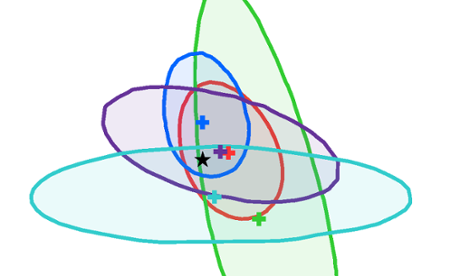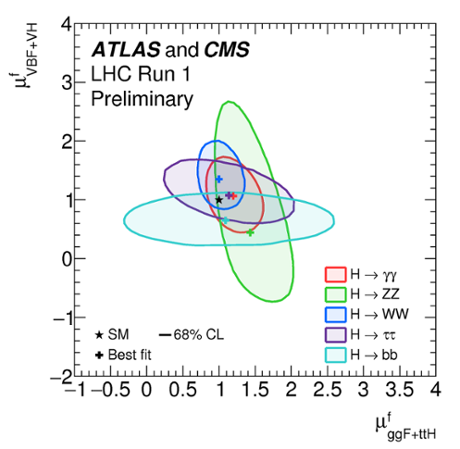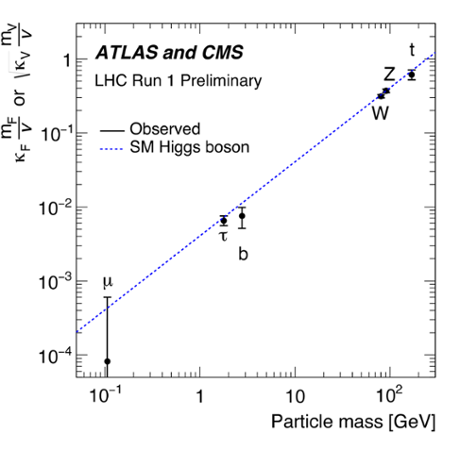
Another of those “freak” research publications, which so befuddle the makers of university league tables, is on the way¹. Having made the best independent measurements they could with the data taken between 2010 and 2012, the ATLAS and CMS collaborations have now combined their results to produce the clearest picture so far of how the Higgs boson is produced, and how it decays.
The result is preliminary so far - though much detail is already publicly available. It follows a similar kind of combination of data pinning down the mass of the Higgs boson.
The basic method is to count the proton-proton collisions in which a Higgs boson is produced, and then use features of those collisions to categorise them. The features used include the particles the Higgs boson produced when it decayed, and other particles produced at the same time as the Higgs boson. The numbers of events in the different categories contain information about how the Higgs interacts with the other fundamental particles, and those interactions are expressed by dimensionless numbers called “couplings”.

The figure above shows how often a Higgs is produced via a W or Z boson (along the vertical axis) or without one (along the horizontal axis). Both axes are normalised to the prediction of the Standard Model, so a value of unity means perfect agreement, and the prediction is shown by the black star. The theory and the data are very consistent. Furthermore, this is true whichever way the Higgs happens to decay - the different coloured blobs are for different decays, and the black star lies within all of them.
The figure below takes the same data and extracts the coupling of the Higgs to different particles. This coupling is what gives the mass to the particles, and so it is right at the core of Higgs physics. If the Higgs boson is really connected to mass in the way we think it is, the coupling should be proportional² to the mass. The fact that the points below are all close to the straight line is our best evidence to date that this is true.

It is also worth mentioning that more detailed differential and fiducial measurements of the Higgs boson have also been made by both ATLAS and CMS, along the lines of the top measurements I discussed here. Again, this is the way of the future as we collect more data.
The whole procedure of combining results from independent experiments can throw up some interesting features. The main improvement in the Higgs results comes from improved statistics, and doubling statistics shrinks your statistical uncertainties by a factor of about square root of two, i.e. ~1.41, so naively at least an improvement of 30-40%.
I remember when the H1 and ZEUS³ experiments at HERA made a combination of their data on electron-proton scattering cross sections however, there were some surprises. Some of the uncertainties were reduced by much more than 40%. This was welcome, but counter-intuitive and it did cause some consternation.
It happens because the precision of many of the measurements is dominated by systematic uncertainties. The measurements cover a wide range of energies and angles at which electrons scatter of protons. In some parts of this range, H1 was more accurate, and in others ZEUS was more accurate. Because the uncertainties of each individual experiment were highly correlated across energies and angles, this meant that in some places the H1 measurements would shrink the uncertainty, which effectively reduced the uncertainty in the ZEUS measurement, which then carried forward to other energies and angles where H1 was not so precise, and could shrink the uncertainty there too; and vice versa and so on.
Done carefully, this is a very powerful technique, and yet another reason for having more than one independent measurement with independent uncertainties. The H1+ZEUS measurement is the most precise information we have on how quarks and gluons are distributed inside the proton, just as the ATLAS+CMS measurement is now the most precise information we have on how fundamental particles acquire mass.
¹ To be honest, by the criteria in that link, all ATLAS and CMS papers are “freaks”
² There is a slightly different dependence for the W and Z bosons, because they have a special relationship with the Higgs, but this is accounted for in the figure.
³ I used to work on the ZEUS experiment.
Jon Butterworth’s book Smashing Physics is available as “Most Wanted Particle” in Canada & the US and is on the shortlist for the Royal Society Winton Prize for Science Books. He is also on Twitter.







